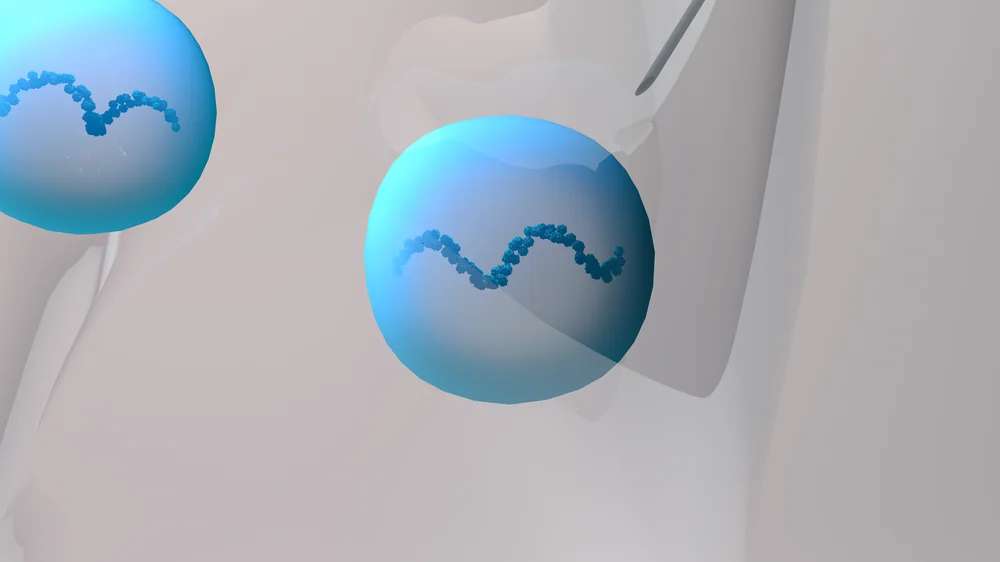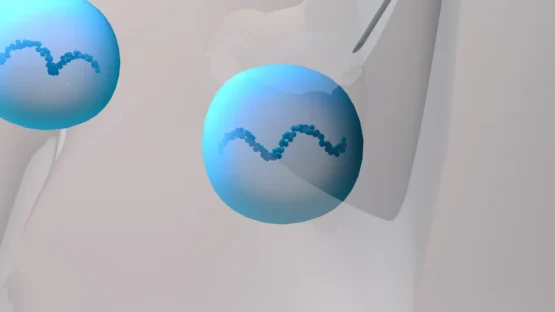Scientists have found that bubbles secreted by embryonic stem cells counter cellular senescence, in large part due to just two tiny snippets of RNA [1].
Helpful bubbles
Extracellular vesicles (EVs) are membrane-bound tiny bubbles that are loaded with various molecular cargo, such as proteins, DNA, or RNA, that cells secrete as a method of intercellular communication. According to numerous studies, EVs can recapitulate many effects of cellular therapies, such as stem cell treatments [2].
In this new study, the researchers used EVs derived from human embryonic stem cells (ESC) against cellular senescence. ESCs are considered a potent therapeutic, tool but, as the study’s authors note in the introduction, their use “is limited by immune rejection, tumorigenicity and ethical issues”. If we could culture ESCs and use EVs secreted by them to the same effect, this would solve many problems.
Smashing senescence in vitro
First, the researchers confirmed that ESC-derived EVs ameliorate cellular senescence in vitro. Cellular senescence is a state in which the cell stops proliferating due to any of several senescence-inducing stressors. Such cells secrete molecules that can induce inflammation and senescence in neighboring cells. While senescence has a role in development and wound healing, it is widely accepted that age-related excessive senescence is harmful [3].
Since cells become senescent after a certain number of divisions, the researchers used mouse embryonic fibroblasts (MEF) that accumulated seven divisions as their in vitro senescence model. EV treatment ameliorated several markers of senescence, not just chemical ones (p21, β-galactosidase) but also senescence-typical morphology, which is when cells become flat and shapeless. Moreover, EVs increased the percentage of proliferative cells to the levels comparable with young control cells.
Tiny snippets of RNA
The question is, then, what cargo were those EVs carrying, and which part of it was responsible for ameliorating senescence in MEFs? Previous research has demonstrated that EVs contain large amounts of microRNA (miRNA): short RNA snippets, typically about 22 nucleotides in length. Despite their tiny size, miRNAs can play important roles, such as regulating protein production by repressing messenger RNA (mRNA). One study found that EVs secreted by healthy cells in the hypothalamus can slow aging and that this effect is partially mediated by miRNA contained in those EVs [4].
The researchers, hence, focused their attention on miRNAs and performed miRNA sequencing of the EVs. Compared to mouse fibroblasts, in ESC-EVs, 128 miRNAs were upregulated and 110 were downregulated. Hypothesizing that the anti-aging effect is most probably produced by enriched miRNAs, the researchers scrutinized the first group.
Many of those miRNAs are known to participate in longevity-related pathways, such as mTOR and insulin signaling. Eventually, the researchers narrowed the list down to just six miRNAs that were both highly enriched in ESC-EVs and downregulated in aged cells.
When the researchers transfected aged MEFs with synthetic RNA molecules that mimic the function of a naturally occurring miRNA (miRNA mimics), two of these mimics, those of miR-15b-5p and miR-290a-5p, were especially effective in alleviating the cells’ senescent phenotype.
Down to one gene
One last remaining question was, which genes are affected by those two beneficial miRNAs? The researchers identified 11 target genes of miR-15b-5p and 10 target genes of miR-290a-5p, but only three were overlapping, and only two of them, Ccn2 and Lurap1, are known to be involved in age-related pathways. Lurap1 activates the potent inflammatory transcription factor NF-κB, and Ccn2 plays a major role in cellular senescence. However, only the latter was significantly downregulated in aged MEFs by the EV treatment.
Inhibiting either of the two miRNAs reduced the anti-senescence potential of MSC-EVs only slightly. However, inhibiting both abrogated it almost completely. Genetic knockdown of Ccn2 significantly decreased the expression of several age-related genes in MEFs, reversed their aged phenotype, and restored their proliferative ability, confirming Ccn2’s important role in senescence.
Finally, the researchers found that MSC-derived EVs induce signs of rejuvenation in aged mice. The treatments caused a major shift in the transcriptome, bringing it close to a youthful one. EVs also induced youthful histological changes in the liver and the kidneys.
Here, we investigate the antisenescence effects of ESC-EVs in vivo using aged mice. Our data show that ESC-EVs treatment rescues the transcriptome profile of aged mice and ameliorates the senescence status of several aged organs, providing evidence that ESC-EVs may be candidates for the therapy of various age-related diseases. Furthermore, we identify miR-15b-5p and miR-290a-5p, which are enriched in ESC-EVs and exert rejuvenating effects by silencing of the Ccn2-mediated AKT signaling pathway.
Literature
[1] Yu, L., Wen, H., Liu, C., Wang, C., Yu, H., Zhang, K., … & Liu, N. (2023). Embryonic stem cell-derived extracellular vesicles rejuvenate senescent cells and antagonize aging in mice. Bioactive Materials, 29, 85-97.
[2] Weng, Z., Zhang, B., Wu, C., Yu, F., Han, B., Li, B., & Li, L. (2021). Therapeutic roles of mesenchymal stem cell-derived extracellular vesicles in cancer. Journal of hematology & oncology, 14, 1-22.
[3] Di Micco, R., Krizhanovsky, V., Baker, D., & d’Adda di Fagagna, F. (2021). Cellular senescence in ageing: from mechanisms to therapeutic opportunities. Nature reviews Molecular cell biology, 22(2), 75-95.
[4] Zhang, Y., Kim, M. S., Jia, B., Yan, J., Zuniga-Hertz, J. P., Han, C., & Cai, D. (2017). Hypothalamic stem cells control ageing speed partly through exosomal miRNAs. Nature, 548(7665), 52-57.Chicago




